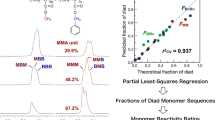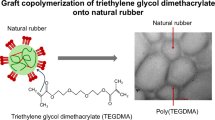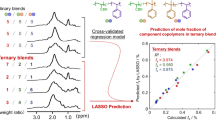Abstract
In this paper, we report chemometric approach for structural analysis of branched copolymers. To evaluate chemical compositions and degree of branching (DB) values in branched copolymers, multivariate analyses, such as principal component analysis (PCA) and partial least-squares (PLS) regression, were applied to the 13C nuclear magnetic resonance (NMR) spectra of the carbonyl carbons of the copolymers prepared by initiator-fragment incorporation radical copolymerization of ethylene glycol dimethacrylate (EGDMA) and tert-butyl methacrylate (TBMA) with dimethyl 2,2′-azobisisobutyrate (MAIB). PCA successfully extracted information on monomeric units, such as EGDMA units, TBMA units and MAIB fragments, the last of which were incorporated via initiation and primary radical termination. The chemical compositions and DB values of the copolymers were predicted by PLS regression. Proper selection of a training set was found to be important for the prediction: the training set has to contain branched copolymers along with poly(EGDMA) and poly(TBMA). PLS regression using the appropriate training set allowed us to predict quantitatively the chemical compositions and DB values, without any assignments of the individual peaks.
Similar content being viewed by others
Log in or create a free account to read this content
Gain free access to this article, as well as selected content from this journal and more on nature.com
or
References
Kim, Y. H. Hyperbranched polymers 10 years after. J. Polym. Sci., Part A Polym. Chem. 36, 1685–1698 (1998).
Inoue, K. Functional dendrimers, hyperbranched and star polymers. Prog. Polym. Sci. 25, 453–571 (2000).
Jikei, M. & Kakimoto, M.-A. Hyperbranched polymers: a promising new class of materials. Prog. Polym. Sci. 26, 1233–1285 (2001).
Tomalia, D. A. & Fréchet, J. M. J. Discovery of dendrimers and dendritic polymers: a brief historical perspective. J. Polym. Sci., Part A Polym. Chem. 40, 2719–2728 (2002).
Gao, C. & Yan, D. Hyperbranched polymers: from synthesis to applications. Prog. Polym. Sci. 29, 183–275 (2004).
Voit, B. Hyperbranched polymers—all problems solved after 15 years of research? J. Polym. Sci., Part A Polym. Chem. 43, 2679–2699 (2005).
Higashihara, T., Segawa, Y., Sinananwanich, W. & Ueda, M. Synthesis of hyperbranched polymers with controlled degree of branching. Polym. J. 44, 14–29 (2012).
Sato, T., Sato, N., Seno, M. & Hirano, T. Initiator-fragment incorporation radical polymerization of divinylbenzene in the presence of glyoxylic oxime ether: formation of soluble hyperbranched polymer. J. Polym. Sci., Part A Polym. Chem. 41, 3038–3047 (2003).
Sato, T., Arima, Y., Seno, M. & Hirano, T. Formation of a soluble hyperbranched polymer via initiator-fragment incorporation radical copolymerization of divinyl adipate and isobutyl vinyl ether. Polym. Int. 53, 1138–1144 (2004).
Sato, T., Hashimoto, M., Seno, M. & Hirano, T. Soluble hyperbranched polymer through initiator-fragment incorporation radical copolymerization of ethylene glycol dimethacrylate and α-ethyl β-N-(α'-methylbenzyl) itaconamate in benzene. Eur. Polym. J. 40, 273–282 (2004).
Sato, T., Higashida, N., Hirano, T. & Seno, M. Initiator-fragment incorporation radical copolymerization of divinylbenzene and N-isopropylacrylamide with dimethyl 2,2'-azobisisobutyrate: formation of soluble hyperbranched polymer nanoparticle. J. Polym. Sci., Part A Polym. Chem. 42, 1609–1617 (2004).
Sato, T., Ihara, H., Hirano, T. & Seno, M. Formation of soluble hyperbranched polymer through the initiator-fragment incorporation radical copolymerization of ethylene glycol dimethacrylate with N-methylmethacrylamide. Polymer 45, 7491–7498 (2004).
Sato, T., Miyagi, T., Hirano, T. & Seno, M. Initiator-fragment incorporation radical polymerization of ethylene glycol dimethacrylate in the presence of 1,1-diphenylethylene: synthesis and characterization of soluble hyperbranched polymer nanoparticles. Polym. Int. 53, 1503–1511 (2004).
Hirano, T., Ihara, H., Miyagi, T., Wang, H., Seno, M. & Sato, T. Formation of soluble hyperbranched polymer nanoparticles by initiator-fragment incorporation radical polymerization of ethylene glycol dimethacrylate. Macromol. Chem. Phys. 206, 860–868 (2005).
Hirano, T., Tanaka, K., Wang, H., Seno, M. & Sato, T. Effect of nitrobenzene on initiator-fragment incorporation radical polymerization of divinylbenzene with dimethyl 2,2'-azobisisobutyrate. Polymer 46, 8964–8972 (2005).
Sato, T., Arima, Y., Seno, M. & Hirano, T. Initiator-fragment incorporation radical polymerization of divinyl adipate with dimethyl 2,2'-azobis(isobutyrate): kinetics and formation of soluble hyperbranched polymer. Macromolecules 38, 1627–1632 (2005).
Hirano, T., Higashida, N., Wang, H. & Sato, M. S. T. Synthesis and characterization of soluble hyperbranched polymer via initiator-fragment incorporation radical polymerization of divinylbenzene with dimethyl 2,2'-azobisisobutyrate. J. Appl. Polym. Sci. 100, 664–670 (2006).
Sato, T., Nakamura, T., Seno, M. & Hirano, T. Soluble hyperbranched copolymer via initiator-fragment incorporation radical copolymerization using a trivinyl monomer. Polymer 47, 4630–4637 (2006).
Sato, T., Nobutane, H., Hirano, T. & Seno, M. Hyperbranched acrylate copolymer via initiator-fragment incorporation radical copolymerization of divinylbenzene and ethyl acrylate: synthesis, characterization, hydrolysis, dye-solubilization, Ag particle-stabilization, and porous film formation. Macromol. Mater. Eng. 291, 162–172 (2006).
Sato, T., Nomura, K., Hirano, T. & Seno, M. Initiator-fragment incorporation radical polymerization of diallyl phthalate: kinetics, formation of hyperbranched polymer, and iridescent porous film thereof. J. Appl. Polym. Sci. 102, 408–415 (2006).
Sato, T., Nomura, K., Hirano, T. & Seno, M. Hyperbranched polymer through initiator-fragment incorporation radical copolymerization of divinyl adipate with allyl acetate: synthesis, characterization, dye solubilization, metal-nanoparticle stabilization, and porous film formation. Polym. J. 38, 240–249 (2006).
Flory, P. J. Molecular size distribution in three dimensional polymers. I. gelation1. J. Am. Chem. Soc. 63, 3083–3090 (1941).
Stockmayer, W. H. Theory of molecular size distribution and gel formation in branched-chain polymers. J. Chem. Phys. 11, 45–55 (1943).
Stockmayer, W. H. Theory of molecular size distribution and gel formation in branched polymers II. general cross linking. J. Chem. Phys. 12, 125–131 (1944).
Momose, H., Hattori, K., Hirano, T. & Ute, K. Multivariate analysis of 13C NMR spectra of methacrylate copolymers and homopolymer blends. Polymer 50, 3819–3821 (2009).
Momose, H., Maeda, T., Hattori, K., Hirano, T. & Ute, K. Statistical determination of chemical composition and monomer sequence distribution of poly(methyl methacrylate-co-tert-butyl methacrylate)s by multivariate analysis of 13C NMR spectra. Polym. J. 44, 808–814 (2012).
Hirano, T., Anmoto, T., Umezawa, N., Momose, H., Katsumoto, Y., Oshimura, M. & Ute, K. Application of multivariate analysis of NMR spectra of poly(N-isopropylacrylamide) to assignment of stereostructures and prediction of tacticity distribution. Polym. J. 44, 815–820 (2012).
Hawker, C. J., Lee, R. & Frechet, J. M. J. One-step synthesis of hyperbranched dendritic polyesters. J. Am. Chem. Soc. 113, 4583–4588 (1991).
Acknowledgements
This work was supported in part by KAKENHI (a Grant-in-Aid for Young Scientists (B) (23750130)).
Author information
Authors and Affiliations
Corresponding author
Ethics declarations
Competing interests
The authors declare no conflict of interest.
Additional information
Supplementary Information accompanies the paper on Polymer Journal website
Supplementary information
Rights and permissions
About this article
Cite this article
Hirano, T., Kamiike, R., Hsu, Y. et al. Multivariate analysis of 13C NMR spectra of branched copolymers prepared by initiator-fragment incorporation radical copolymerization of ethylene glycol dimethacrylate and tert-butyl methacrylate. Polym J 48, 793–800 (2016). https://doi.org/10.1038/pj.2016.16
Received:
Revised:
Accepted:
Published:
Issue date:
DOI: https://doi.org/10.1038/pj.2016.16
This article is cited by
-
Multivariate statistical analyses of 1H NMR data for binary and ternary copolymer blends to determine the chemical compositions and blending fractions of the components
Polymer Journal (2023)
-
Determination of monomer reactivity ratios from a single sample using multivariate analysis of the 1H NMR spectra of poly[(methyl methacrylate)-co-(benzyl methacrylate)]
Polymer Journal (2022)
-
Multivariate analysis of 13C NMR spectra to extract information about monomer sequences in poly(methyl methacrylate-co-benzyl methacrylate)s prepared by various polymer reactions
Polymer Journal (2018)



